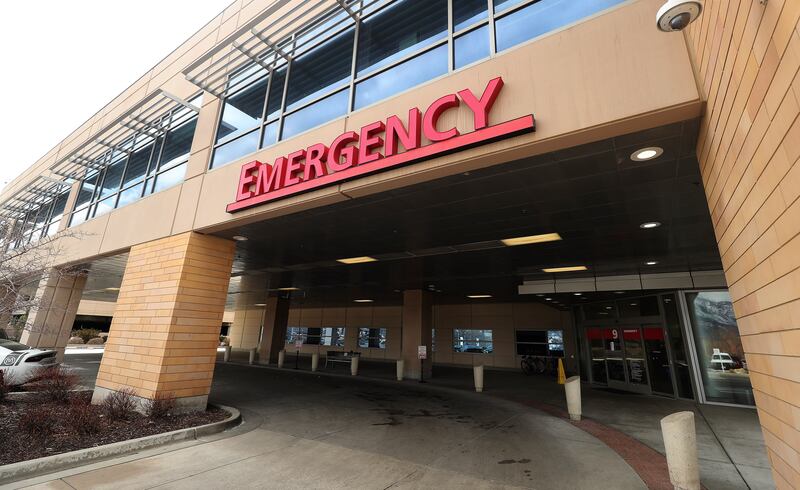Hospital intensive care units across the Intermountain Healthcare system, the region’s largest, are at 100% capacity and Utahns should be wearing masks and taking other precautions against COVID-19 whether they’ve been vaccinated against the virus or not, a doctor advised Friday.
And unlike during last winter’s coronavirus surge, hospitals no longer have the staff necessary to expand capacity because of the toll the pandemic has taken on many medical professionals, Dr. Brandon Webb, an Intermountain Healthcare infectious diseases physician, told reporters during a virtual news conference.
His comments came shortly before the Utah Department of Health reported 1,286 new COVID-19 cases, including 250 among school-aged children, and eight additional deaths from the virus. The rolling seven-day average for positive tests in Utah is now at s 1,176 per day.
“We really are sympathetic to caregivers across the board who are experiencing a lot of fatigue and burnout. I think that a lot of our health care professionals are tired of being heroes. They’re just tired,” Webb said, urging Utahns to let them know they’re appreciated. “That matters. It’s very meaningful to us.”
He said nurses, respiratory therapists and others were so “severely impacted” that they’ve left their jobs, leaving hospitals in Utah as well as “the rest of the country understaffed as COVID-19 cases continue to climb, driven by the highly contagious delta variant.
“That’s the reality,” Webb said. “We might have physical space but we don’t have the personnel.”
Intermountain Healthcare is dealing with the deluge by moving patients between facilities when needed, he said. Typically, hospital intensive care units are considered full at about 80% to ensure emergency cases can be handled.
Now, Webb said, hospitals are seeing not only are there more COVID-19 cases, including in children, but as Utahns are returning to travel and other activities this summer, the trauma cases are piling up, too. Still, the doctor said Intermountain Healthcare doesn’t expect to have to turn away patients.
He blamed the delta variant, which is not only more transmissible but also likely more virulent than earlier strains of the virus, for more children and younger adults becoming ill enough to need hospital care. Many also have other health concerns, such as obesity or high blood pressure, Webb said.
Because people are being exposed to higher amounts of COVID-19 when they come in contact with someone who has contracted the delta variant of the virus, adding another layer of protection on top of the vaccine is more important than ever, the doctor said.
That means wearing masks, social distancing and avoiding gatherings, especially indoors, he said, even for those who are fully vaccinated, meaning it’s been two weeks or more since their final dose, because breakthrough cases of COVID-19 are also rising,
“Those two layers coupled together have the power to stop COVID. It’s just a matter of can we do it effectively enough to drive the numbers down to where they were” before the latest surge started earlier this summer, Webb said.
The rate of breakthrough cases in the fully vaccinated correlates to the overall vaccination rate, he said, so the count is expected to increase. Those who experience a breakthrough case tend to have fewer and less severe symptoms and are not as likely to be hospitalized or die from the virus, he said.
“While the breakthrough infection rates can be a little disappointing, I think we can still remain very encouraged that there are benefits to vaccination, both protective and also on the side of protecting against severe infection and outcomes,” Webb said.
Still, Utahns need to be “aware that the vaccine itself does not create a force field around you,” he said, instead enhancing the body’s immune response to an infection.
“That doesn’t create a barrier to being exposed to the virus itself. It simply means that when you’re exposed, your body is better equipped to deal with it,” Webb said.
The 1,286 new Utah cases reported Friday include 110 cases in 5- to 10-year-olds; 62 cases in 11- to 13-year-olds; and 78 cases in 14- to 18-year-olds. COVID-19 vaccines are available to anyone 12 and older, and the state has administered a total of nearly 3.2 million doses, a daily increase of 7,881.
The state health department calculates that since Feb. 1, Utahns who are not vaccinated against COVID-19 are at 4.9 times greater risk of testing positive for the virus, and at 5.6 times greater risk of hospitalization and 6.1 times greater risk of death than someone who is vaccinated.
There have been more than 3.1 million Utahns tested for the coronavirus since the pandemic began in March 2020, a daily increase of 8,953. A total of more than 5.6 million COVID-19 tests have been conducted in the state, including 15,634 since Thursday.
The rolling seven-day average for percent positivity of tests is 10.8% when all results are included and 15.4% when multiple tests by an individual are excluded.
Currently, 467 people are hospitalized in Utah with COVID-19, bringing the total number of hospitalizations in the state since the start of the pandemic to just over 20,000. The eight additional deaths reported Friday put Utah’s death toll from the virus at 2,623. They are:
- A Salt Lake County woman, between 45 and 64, hospitalized at time of death.
- A Utah County man, between 45 and 64, hospitalized at time of death.
- A Utah County man, between 25 and 44, not hospitalized at time of death.
- A Weber County man, between 65 and 84, not hospitalized at time of death.
- A Davis County man, between 45 and 64, long-term care facility resident.
- A Wasatch County woman, between 65 and 84, hospitalized at time of death.
- A Salt Lake County man, between 65 and 84, hospitalized at time of death.
- A Utah County woman, between 65 and 84, hospitalized at time of death.


